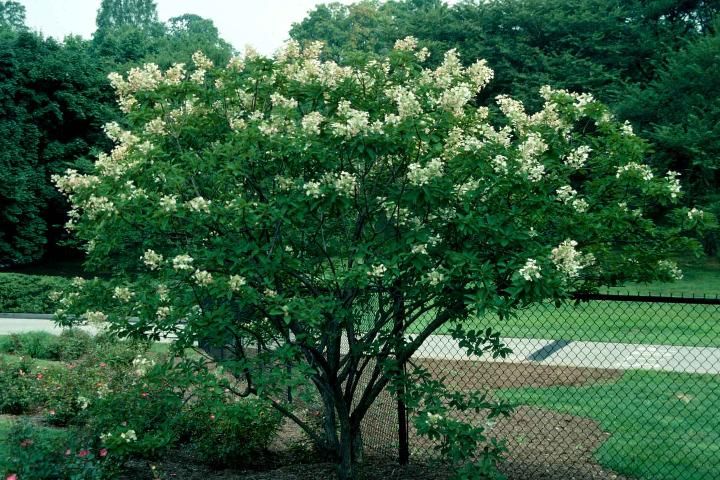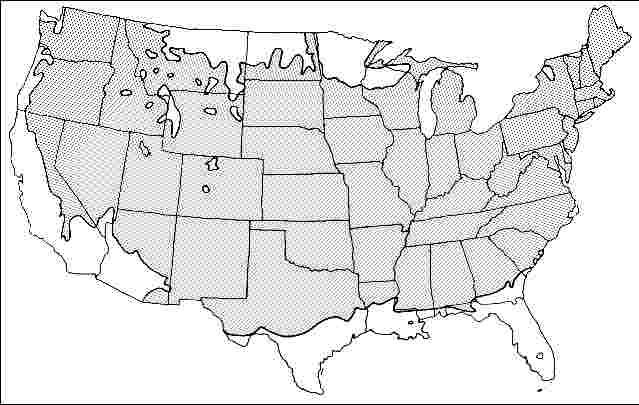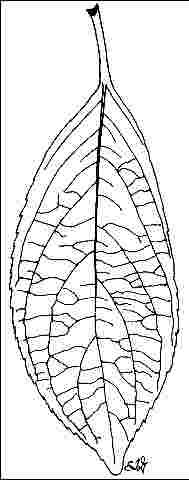Introduction
This low-branching, multiple-trunked tree or large shrub is fast-growing and capable of reaching 15 to 25 feet in height with a spread of 10 to 20 feet but is often seen at about 10 feet. The dark green, deciduous leaves are three to six inches long and 1.5 to 3 inches wide, and fade only to a sickly yellow in fall before dropping. The spectacular summertime blooms appear in six to eight-inch-long panicles, the cream-colored flowers gradually fading over time to purplish-pink. The upright, spreading branches often bend down with the weight of the blooms, and the brown, faded blooms should be removed in late September to keep the tree from looking unkempt. If unpruned some people object to the pinkish brown fruits and old flowers which hang on to the tree during the winter. Pruning also is suggested to keep the plant to a consistent, neat shape.

Credit: Ed Gilman
General Information
Scientific name: Hydrangea paniculata
Pronunciation: high-DRAN-jee-uh pan-ick-yoo-LAY-tuh
Common name(s): Panicle Hydrangea
Family: Hydrangeaceae
USDA hardiness zones: 4A through 8A (Fig. 2)
Origin: not native to North America
Invasive potential: little invasive potential
Uses: hedge; specimen; deck or patio; trained as a standard; container or planter; screen
Availability: somewhat available, may have to go out of the region to find the tree

Description
Height: 15 to 25 feet
Spread: 10 to 20 feet
Crown uniformity: irregular
Crown shape: vase
Crown density: moderate
Growth rate: moderate
Texture: coarse
Foliage
Leaf arrangement: opposite/subopposite (Fig. 3)
Leaf type: simple
Leaf margin: serrate
Leaf shape: elliptic (oval), ovate
Leaf venation: pinnate, brachidodrome, bowed
Leaf type and persistence: deciduous
Leaf blade length: 2 to 4 inches, 4 to 8 inches
Leaf color: green
Fall color: yellow
Fall characteristic: not showy

Flower
Flower color: white/cream/gray
Flower characteristics: very showy
Fruit
Fruit shape: elongated, oval
Fruit length: .5 to 1 inch
Fruit covering: dry or hard
Fruit color: brown, pink
Fruit characteristics: does not attract wildlife; showy; fruit/leaves not a litter problem
Trunk and Branches
Trunk/bark/branches: branches droop; not showy; typically multi-trunked; thorns
Pruning requirement: needed for strong structure
Breakage: susceptible to breakage
Current year twig color: brown, gray
Current year twig thickness: thick
Wood specific gravity: unknown
Culture
Light requirement: full sun, partial sun or partial shade
Soil tolerances: clay; sand; loam; alkaline; acidic; well-drained
Drought tolerance: moderate
Aerosol salt tolerance: unknown
Other
Roots: not a problem
Winter interest: no
Outstanding tree: yes
Ozone sensitivity: unknown
Verticillium wilt susceptibility: resistant
Pest resistance: sensitive to pests/diseases
Use and Management
Panicle Hydrangea can be used in a shrub border as a large sized accent shrub. It may be best to locate it away from the house due to its large size and spreading habit. Lower branches can be pruned to clean up the bottom of the plant and make it grow into a multi-stemmed tree. Early training can create a single-stemmed small tree which would be well suited for planting as a specimen in a low ground cover or lawn area. They are also suited for planting in above-ground containers for displaying the nice flowers which develop in the summer.
Panicle Hydrangea should be grown in full sun or partial shade on well-drained, moist, loamy soil. Plants are fuller in the sun.
Propagation is by softwood cuttings which root quickly in a medium of sand and peat.
Pests
Aphids, rose chafer, oystershell scale, two-spotted mites, and nematodes.
Diseases
Bacterial wilt, bud blight, leaf spot, powdery mildew, and rust.
